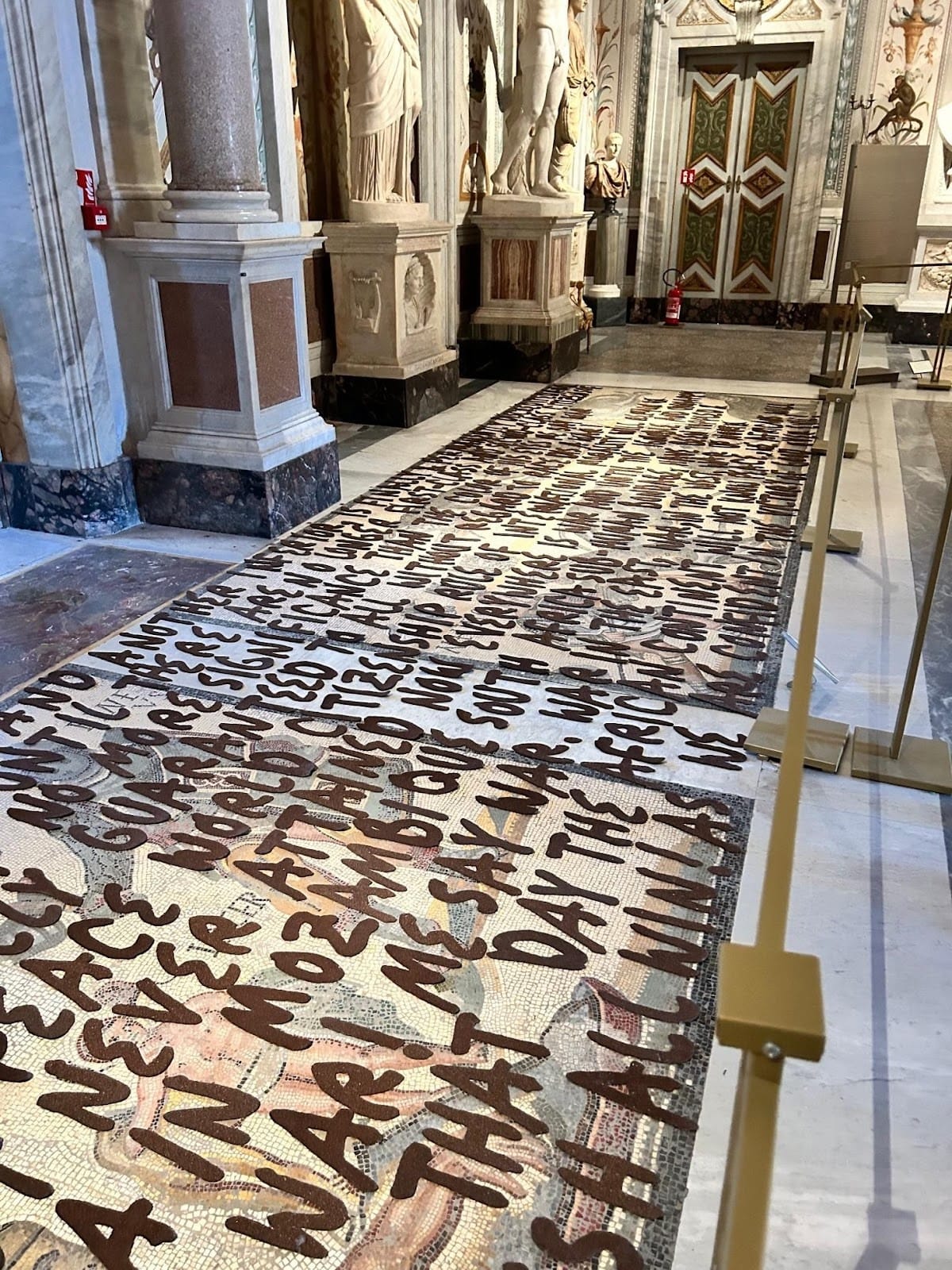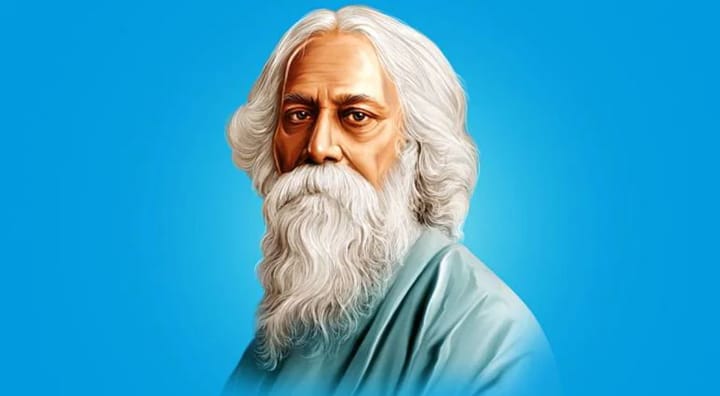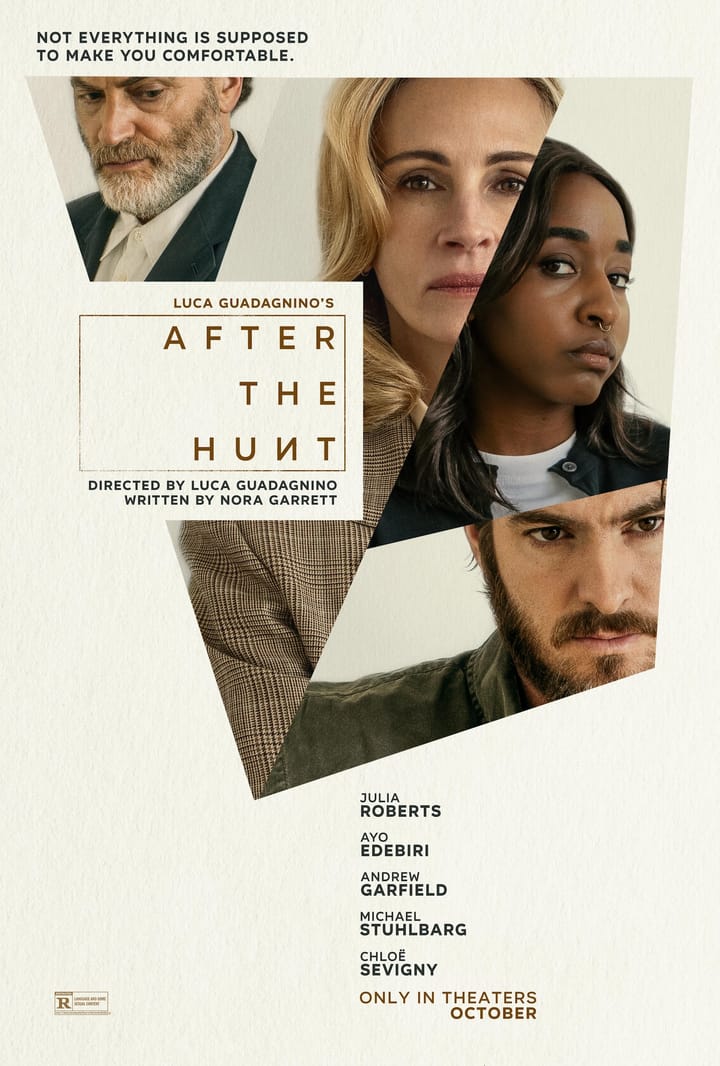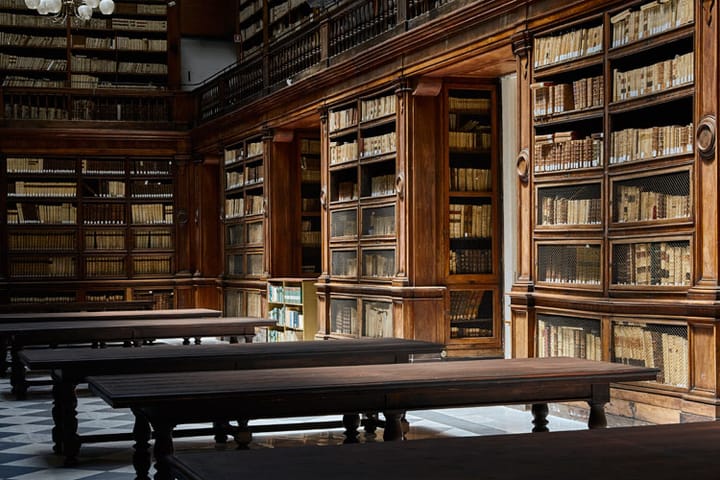In the heat of July in Rome, we discussed the exhibition ‘Black Soil Poems’ (brilliantly curated by Cloé Perrone) by Kenyan artist Wangechi Mutu at the Galleria Borghese. A certain dissonance was inevitable in the conversation with the writer and journalist Igiaba Scego and Andrea Viliani, director of the Museum of Civilisations (Rome). On the one hand, we were there to recognise Mutu’s place in the art world. On the other, however, we were also faced with the challenge of responding to the invitation to talk about ‘African cultures and decolonisation’. How can one talk about art in the context of Africa and decolonisation? Just asking the question shatters the readily available definitions and conclusions.
There is an inevitable awkwardness in talking about Africa, as if it were an object of study to be made transparent to our desire for knowledge and power. This leads to the recognition that people living further south, on the other side of the Mediterranean and Sahara, only discovered they were in Africa and that they were Black when the Europeans arrived. These dark mirrors, reflecting a world at the exclusive service of the creation of the West, echo Frantz Fanon’s famous statement that Europe is the product of the Third World.
Rejecting the burden of being ‘Black’ and refusing to bear the burden of representation, Wangechi Mutu’s works propose a multitude of forms and languages that challenge our need for transparency, or rather, our desire to control and dominate the scene, in other words, to colonise it. Breaking the narrative and dispersing its fragments creates another space, decolonised and unauthorised, independent of imposed meanings.
I must therefore seek another critical horizon, which means at least beginning to understand the multiple realities of a vast continent that challenges and interrupts my perspective. Instead of insisting on Europe and the West as a measure to frame ‘Africa’ and recognise what is irreducible to something fixed, stable and homogenous – a fundamentally racist and colonial perspective – I need to begin to register the limits of my language. In acknowledging these limits, I encounter what exceeds me and dismantles my claims on the world.
This involves questioning my inherited history, that is, a particular narrative of time and space that bears the adjective of the West and claims universality. In this sense, decolonisation implies the decomposition of the canon, and working with the sediment, compost and ‘black soil’ that rejects a unique form and meaning. Going against the universal claims of aesthetics, this means insisting on understandings of history and place in their deepest sense. This inevitably implies that Occidental definitions encounter and negotiate other trajectories, which do not simply reflect and respect their chosen coordinates. This leads to cultural openness and historical disruption that are not guaranteed by the previous order. Everything is altogether more exposed.
The Black body, previously the fetishised object of the Western gaze, is now the historical subject that resists and insists against the powers that once structurally and ‘scientifically’ supported its objectification. The body mutates and acquires form in a language that rips off the white mask of art and insists on black skins that generate other aesthetics and analytical discourses. Art, as a concept and institution of undeniable Western origin, is digested and then regurgitated. Stereotypes are explored and broken down in the very act of their dissolution. The dominance of the West is dismembered and reassembled in the transient spaces of planetary modernity. The colonial gaze is disoriented by the ensuing collage, the frame is shattered, the definitive moment of conclusion is postponed. There is no ready foreclosure, as Lacan would say, that allows us to be stitched back into our pre-established positions. We remain vulnerable to what we have neither authorised nor foreseen. This too could be a definition of an art and aesthetics that seek the measure of the world (and not simply of the West, to recall Aimée Césaire and Frantz Fanon’s verdict on Western humanism).
Taxonomies are disrupted and the material proximities of bodies and things realigned. This encapsulates another way of being in the world, where safe distinctions and imposed binaries collapse, where what is human and what is animal become less distinct, and where patterns of materiality challenge the categories that once explained them.
Mutu’s art crosses conceptions of Africa and decolonisation in complex and intriguing ways. It certainly does not offer a mirror or a set of obvious interpretative tools. After all, as James Baldwin once said, artists are here to disturb the peace. Therefore, in thinking with her art, we are invited to make a critical cut on our analytical categories. What do we mean by ‘Africa’ and ‘decolonisation’? Trying to answer these questions leads us to confront how we view modernity and who, repeating Hannah Arendt’s famous phrase, is entitled to rights, including the right to narrate and define it. How we come to understand ‘Africa’ and ‘decolonisation’ intercepts the habitual with critical uncertainty both in the art world and beyond.
In this sense, Mutu’s art cannot be considered a continuation or updating of art history and its exhibition logic, as if it were a further adaptation to accommodate the wider, non-Western world. It is about something more. And what do we mean by Africa? After all, it is fundamentally an invention of Western geography and its colonial philosophy of power. How to dismantle and decolonise this legacy? Can the colonisers decolonise themselves? Since the latter perspective is unlikely, we must hold on to these questions without ready answers.
The linear perspective of the all-encompassing eye/I, is a colonial practice. Through it, the entire world can be observed, catalogued and made transparent to a will, constituting itself as the subject of history. This is what Panofsky called the visualisation of anthropocracy, where ‘man’ was clearly understood as white and western.
Registering these limits requires the recognition of what precedes and exceeds our presence. It implies rejecting the illusion of an exhaustive explanation and fitting Mutu’s works (and Africa) into the categories we have prepared for them. It means abandoning languages that produce objects of analysis that inevitably confirm our perspective, assumptions and prejudices. Therefore, rather than speaking for or on behalf of Mutu’s art, it is perhaps better, as the Algerian writer and filmmaker Assia Djebar insisted, to speak close by, in the vicinity. This implies curbing the colonial imperative of physical and metaphysical possession and its discursive regime of knowledge/power. The ubiquity of the ocular, where everything that cannot be represented tends to be excluded from knowledge, now breaks down. If sight moves in a singular direction – from the sovereign subject outwards through the world to the Kantian reconfirmation of the intellect in the infinite – speaking and listening in the vicinity of histories, cultures and lives that refuse to be objects, bends and curves my language into another space, altogether more vulnerable and less guaranteed. Here the senses multiply and the rhythms of language fail to conclude. Like blues, jazz and all improvised music (including that of the Arab world), we are suspended in the textures and tones of a syntax in the making. As opposed to the knowing with intent to resolve, really listening to the complex conversations of the world involves an unauthorised return. My vision is traversed and transgressed by other bodies and other voices, by others. My trajectory is confronted and challenged without the offer of ready consolation.
Although Wangechi Mutu has also worked extensively with painting and video, at the Galleria Borghese the artist offers us mainly fantastical three-dimensional allegories of the modern condition. They encourage us to travel into another spacetime that is not contained by the marble authority of the Palazzo Borghese. This is particularly evident in works such as Bloody Rug and The Grains of Words.
The rug, stained by the brutal bloodshed of history, disrupts the calmness of the Renaissance paintings on the walls with the insistence of the structural violence of the present seething from the dark archives of the West. After all, as Joseph Conrad taught us, the heart of darkness was never in the Congo, Kenya or Africa, but lay in the colonial machinations of Brussels, London, Paris and... Rome: from papal bulls on the division of the globe, to the financing by Italian maritime republics of the settlement and slave labour of the New World, to direct colonialism in the modern Italian empire in East Africa and Libya.
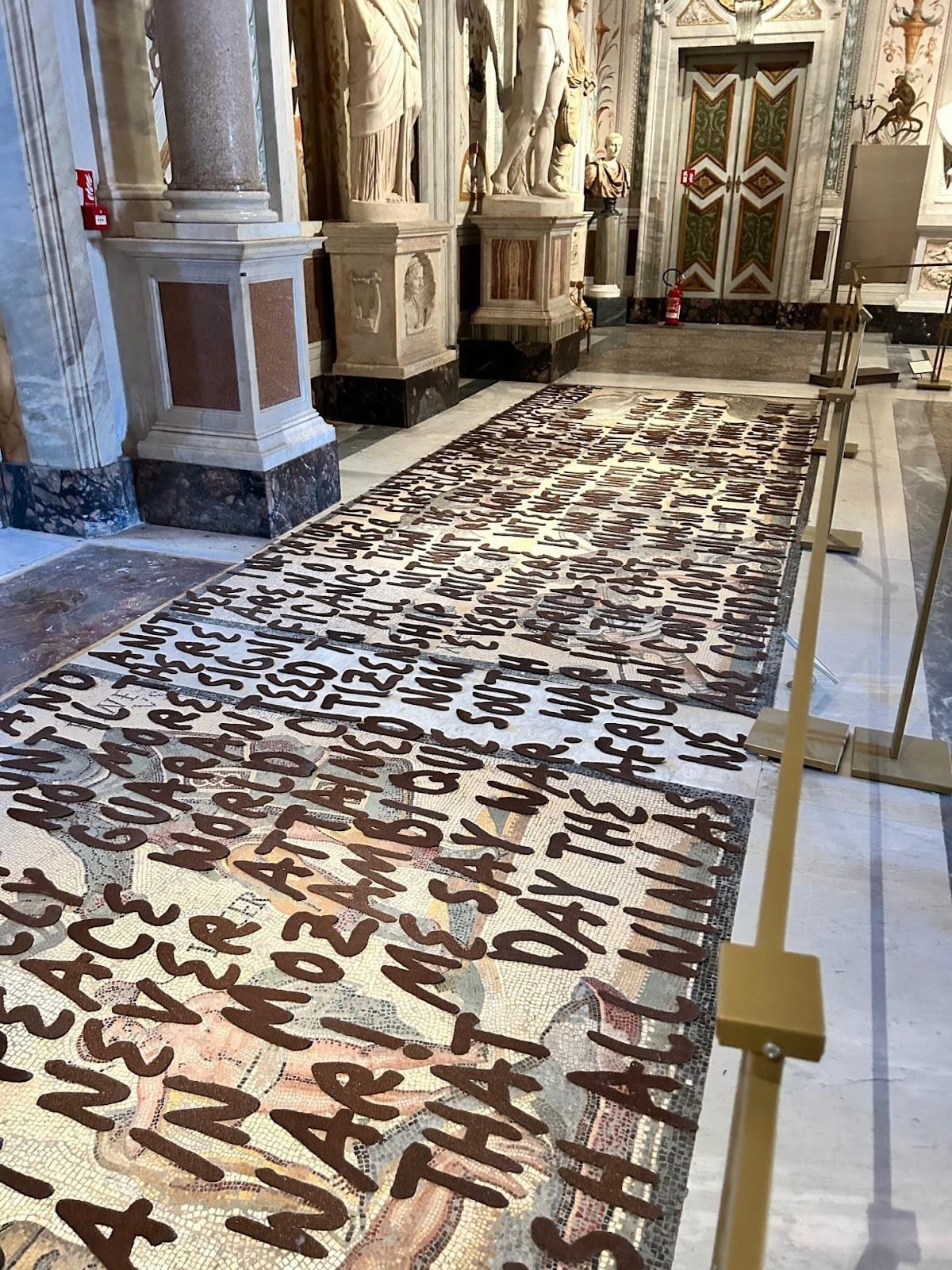
In The Grains of Words, phrases claiming racial justice, taken directly from the song "War" by Bob Marley, invest us with a past that does not pass and insists on the colonial constitution of the present. Written with coffee beans and tea leaves - two essential colonial products that sustain Western daily life - are memories that have been rejected, scattered on the Roman mosaics of the museum floor. The stratified histories of the West become the palimpsest of the sedimented colonial violence constituting the present. The pomposity of the setting, with its marble plinths and statues unintentionally paying homage to whiteness and the supposed universality of its values, is abruptly interrupted. A Caribbean prophet, poet and philosopher sets the space to another rhythm. The reasoning of reggae, rather than the purity of abstract rationality, takes us underneath, creating connections between the subaltern Souths of the world. The floor cracks and the bass resounds. Histories emerge from the abyss, from the ‘bottomless pit’ (Marley), while the margins reassess the centre and shift its authority over history and the world, but without the pretense of a conclusive language to reconfirm our subjective authority. The sounds, the words, the bass lines of the Black Atlantic return to Africa, through the Rastafarian imagery of Ethiopia and the artist’s native Kenya; there to travel without a predetermined destination. The teleology of the West, seduced by the accumulative linearity of a mythical progress, is fragmented. Modernity is no longer just ours to define.
But what does all this mean? Simply the recognition of other bodies and other lives, and a consequent expansion of the political accounting of history? Or is there something deeper? Something that goes beyond a simple modification of our understanding of culture, art and aesthetics? Digging into the black soil, we are confronted with seemingly abstract and neutral concepts, such as reason and aesthetics, that are contaminated, or rather, compounded within the colonial conditions of modernity. In other words, decolonisation implies more than mere adjustment and reconfiguration. It suggests a radical laying bare of the very premises that allow our languages to pass as universal, and therefore true, while we reduce others to local knowledge and anthropological notes. What Wangechi Mutu’s exhibition so powerfully proposes is that this unexpected cut and version is already at work within modernity. If there is no outside, then we must re-evaluate our coordinates and adopt another compass.
Reasoning in the vicinity of Poems by my Great Grandmother 1, elements of locality – the food and the ubiquitous Indian aluminium pot in East Africa – enter and disrupt a predictable aesthetic order. Outside the terrain of locality and tradition, a physical composition presents us with a mapping of the present unknown to most visitors. Or, rather, if there is a resonance and recognition in culinary practices and eating, the deliberate composition of everyday and fantastical utensils, like a surrealist gesture out of Africa, tears the fabric of immediate understanding with other memories and lives. Once again, we have to rework our language.
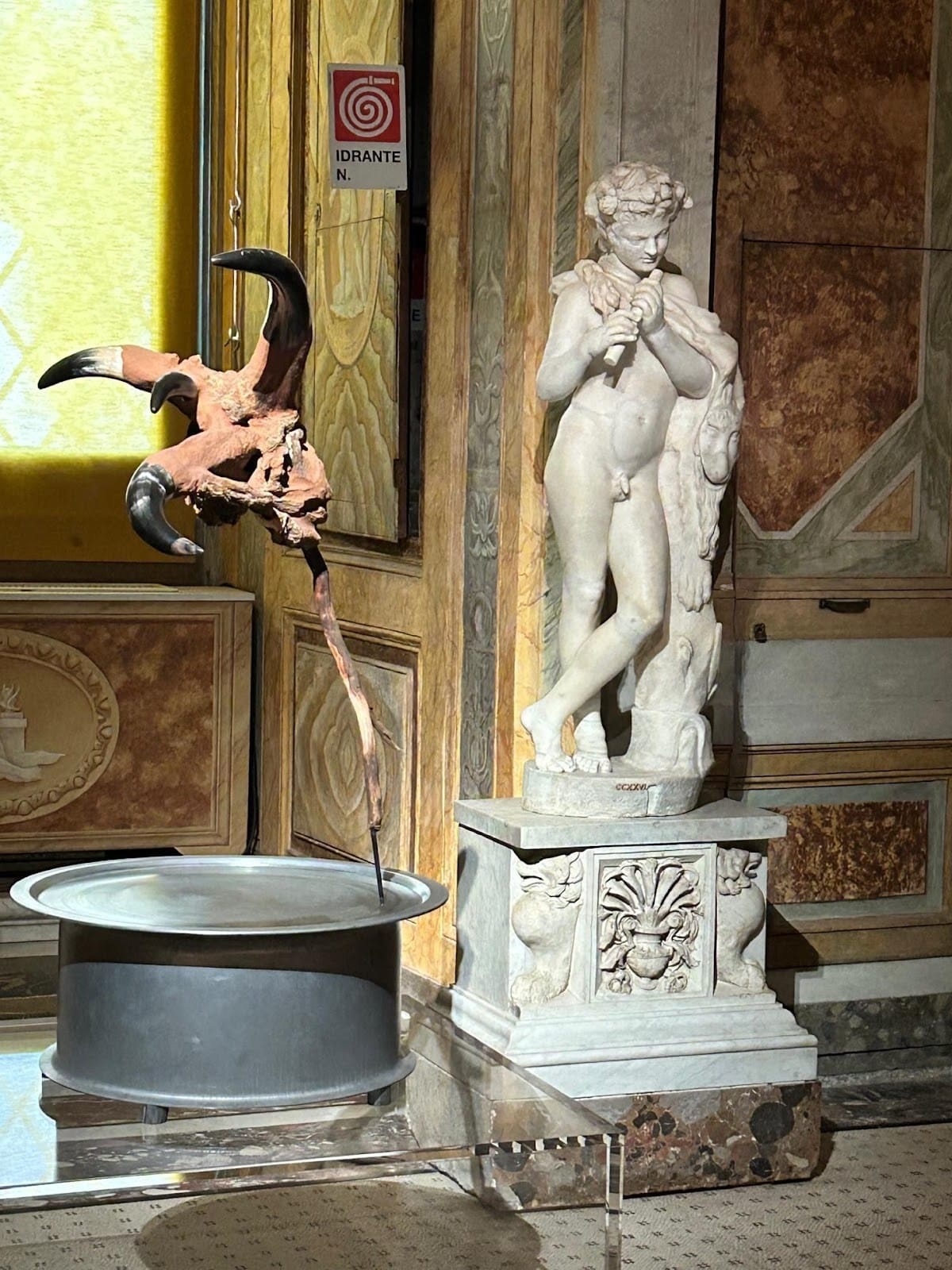
What critic Nicholas Mirzoeff has called the ‘white gaze of abstraction’ has historically only allowed the European system of representation to feign universality. This is not simply an aesthetic issue, as it draws on a racial order that grants only Western subjects the freedom to assume that their judgement - both aesthetic and political - is universal. The limits of geographical location are overcome by the universalising gaze of the liberal subject who is white, Western and invariably male. The modern hierarchisation of world cultures and values depends on the racialisation of the planet to justify a particular political and economic order. Slavery was not a marginal phenomenon, confined to Africa and the plantations of the Americas. It was central to the creation of the political economy of the modern Atlantic world. It continues to haunt the present and forcefully reminds us that racism is not an individual pathology: it is a power structure, central to the moral justification of the West’s colonisation of the planet. The force of this story demands that we interrupt, interrogate and dismantle a way of seeing and violate the existing aesthetic regime.
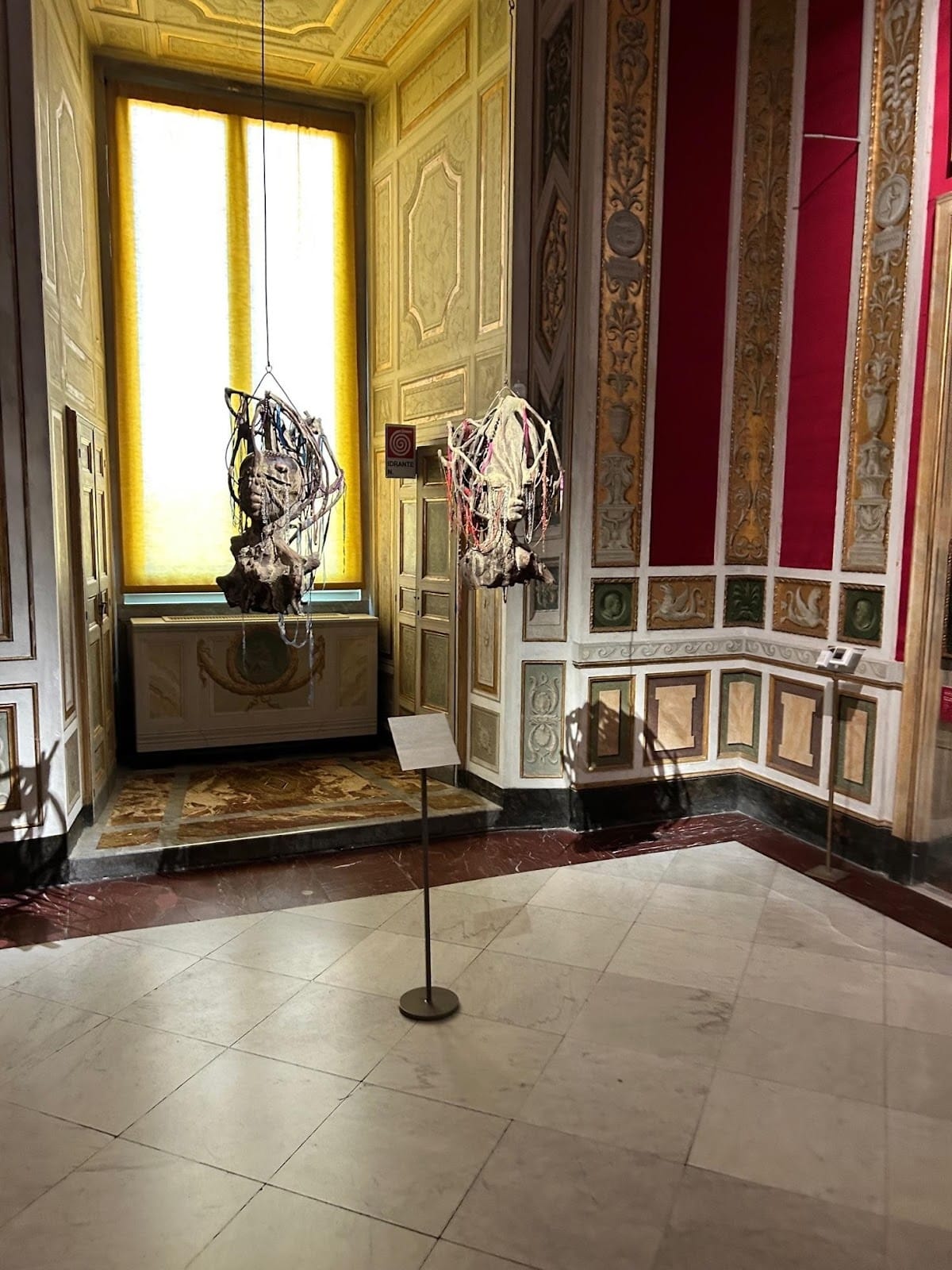
Mutu’s statues, figures and installations cut through space. They fragment it and refuse to stand still. They create flows and force fields that draw on the life of the African diaspora navigating the modern world. Their insistence draws us into the buzz and vibrations of an embodied perception: they are more than statues, more than mere works of art. Something more, something different is operating here. What speaks and announces itself is not an essential Africa, but rather the rupture of what we have defined as ‘Africa’ and refuse to conform to that state. To escape ideas of distant, exotic, anthropological details or ‘primitive’ art, requires that we take another journey through modernity, not necessarily authorised by our premises and perspectives. We are confronted with the Africa within us, the stereotypes and prejudices that maintain our grip on the world, and we begin to learn to live with and move beyond the fragments of that fantasy.
This Africa is on the move. It refuses its location. It is a disruptive, diasporic force. The music of the Black diaspora and the modern Atlantic world is the most powerful testimony to this – from blues and gospel to jazz and soul, R&B, reggae and rap – but it also alerts us to the subversion and subtle translation of the European-derived world elsewhere and everywhere: in language and poetics, in visual arts and urban styles. At the end of the day, and despite violent and unequal power relations, colonialism never moves in only one direction. The coloniser is also colonised. This, as is well known, produces fear and anger as supremacy is challenged and dismantled.
In the vicinity of Mutu’s works, suspended between the coordinates of a solid European art formation, we perceive their Blackness. By this I mean something that goes beyond the simple question of pigmentation. If blackness exists no more than whiteness (“Le Nègre n’est pas. Pas plus que le Blanc”: Frantz Fanon), then Mutu’s works, placed between the white neoclassical statues of Bernini and Canova proposing the physical and metaphysical perfection of Western aesthetics, create another space. This is not simply a deliberate counterpoint. The proximity also invites us to reconsider the deliberate construction of that canonical aesthetic. After all, in the classical Greco-Roman world, statues, like temples, were actually painted in rather garish colours. It is modernity that has chosen to purify and bleach them, producing a modern myth.
There is a definite dissonance. The adjective is deliberately auditory. Mutu’s works invite us to hear another tale, to listen to other stories. Their tactile quality produces an echo in those willing to participate. Transported to respond to the sensations triggered by the works, like the ‘punctum’ proposed by Roland Barthes, they interrupt and question our distracted gaze. The museum is set in motion. Its careful boundaries are crossed by ‘illegal’ movements. Somewhere between Nairobi and New York, Gian Lorenzo Bernini’s Apollo and Daphne is connected to other coordinates. Its absolute authority is challenged by the black siren of the Water Woman. Here, bodies that resist and refuse to reflect the categories and places assigned to them become inventors of existence. A black future creeps into the present. The denied body makes the world another world, highlighting all the limits of our own. This becoming black of the world (Achille Mbembe), precisely because it is not yet fully recognised or only vaguely registered, comes – in an unplanned encounter between Jacques Derrida and Afrofuturism – from the future.
It is no coincidence that my partner, Lidia Curti, chose Mutu’s mermaid as the title page of the volume Femminismi Futuri (2019). She refers to Mutu’s ecological Afro-feminism in the context of Black and feminist science fiction – Octavia Butler and her progeny - where speculative futures make a critical cut on the colonial, racist and patriarchal constitution of the present. It is no coincidence that a 2013 work by Mutu was titled A Fantastic Journey. Her video The End of Eating Everything, from the same year, depicts the monstrosity of a changing world being totally consumed under the regime of cannibal capitalism.
In all this, what I would like to emphasise once again is the rejection of transparency and communicability, which is also a definition of art. Such opacity (Édouard Glissant) and the refusal to appear before our eyes and represent our desires and needs, proposes elusive horizons, deliberately open and inconclusive perspectives. In Mutu’s work, this is based on a Black feminist version of the Fanonian abandonment of Europe and its limited humanism: now exposed in all its obscenity in the eastern Mediterranean, in Gaza and the West Bank. In this promotion of creolisation, where the testimony of Africa’s shifting black terrain invades the marble rigidity of the institutional West to ruin its claims on the world, lie the seeds of decolonisation. Not the sharp replacement of one power paradigm with another, but rather the insidious undoing and remaking that produces a planetary commons insisting that ‘Never Again’ includes everyone.
Here poetics dismantle politics, and language rejects the transparency of rationality that seeks to reconfirm my subjectivity through the objectification of other histories, cultures and lives. This is the challenge of language uprooted within a modernity that is not only our own. The journey proposed in this poetics, in which we lose our orientation to find ourselves in another critical, historical and aesthetic space, invites us to renegotiate our belonging in the coordinates of a more open and potentially more democratic world. Responding to the wounds we Westerners have inflicted on the world does not mean simply acknowledging them only to find ourselves stuck in the narcissism of post-colonial melancholia. To escape this blockage, we must rework our colonial constitution and move from a state of repression to critical responsibility and accountability. I would say that Mutu’s astonishing poetics invests us with this politics.
